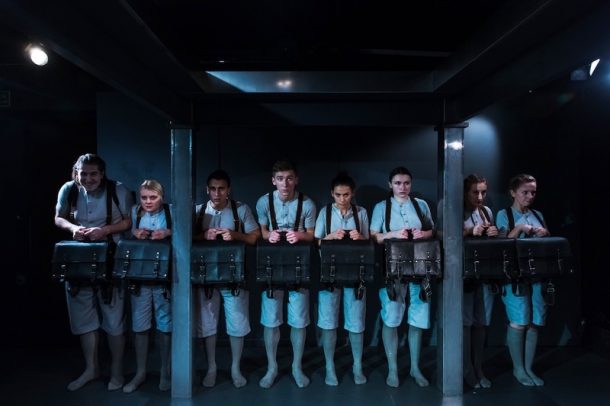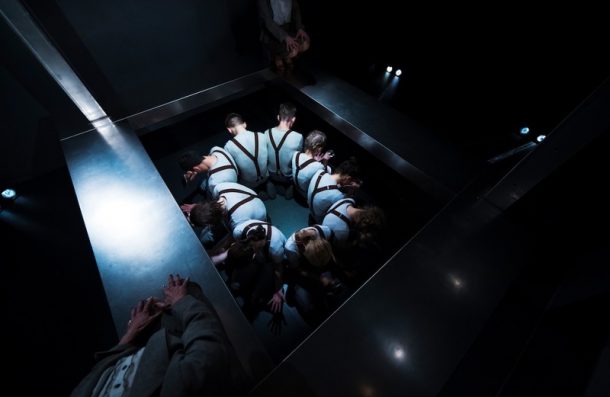Founder and longtime artistic director of Kraków’s Teatr KTO, Jerzy Zoń, traces his choice of a life in theatre to a moment when—still a student—he sat in the audience, weeping, during the 1975 premiere performance of Tadeusz Kantor’s Dead Class: A Séance. It is fitting, then, that Zoń’s creation, Chór Sierot (Chorus of Orphans) was performed in May 2016 at the new Kantor Museum in Kraków where it will play in repertory for several years. Chór Sierot is itself, in some senses, a response to Dead Class, concerned less with the war dead and, instead, concentrating on the predicament of child war survivors. In particular, Chór Sierot focuses on the institutionalization of these children, investigating the state care of humans on at least two levels. First, the play is an abstract, wordless performance of the ordeals suffered by children whose parents died during Poland’s traumatic twentieth century; and, more abstractly, it uses the state-run situation of the orphanage as metaphor for the trial of living in communist-run Poland.
Chór Sierot follows eight children, four boys and four girls, in the orphanage run by two female administrators. It utilizes adult actors to play the children, each in identical gray short pants, knee socks, suspenders, and collarless button-up shirts. Their supervisors are in gray knee-length skirts, sport coats, white button-up blouses, and black high heels. The audience is seated in an alley configuration, and, between, the set is a steel square, marked at each corner by a rectangular steel column, and a steel entablature connecting them all. A visual surprise is that, with effort, the cast can move the entablature up and down, providing new levels to walk on, climb on, reach for, and grapple with. Choreographed precisely to the Symphony No. 3, Op. 36 by Henryk Mikołaj Górecki (Symphony of Sorrowful Songs), Chór Sierot spends fifty-two minutes and thirty-five seconds showing these children fighting to survive against the cruelties visited on them by their peers and administrators. At one point when the entablature is in a low position, the children lie on their stomachs with metal cups in arms outstretched, passing the cups along for the administrators to walk on. When the entablature is at its highest position, the administrators place apples on each corner of the structure for which the children then violently fight. For fun and games, the children enact scenes of cruelty for the pleasure of the administrators with the entablatures forming a ring around the performance space. These and other pantomime sequences are the basis for a highly emotional nightmare of loneliness, suffering, and lack of consolation.

Chór Sierot, directed by Jerzy Zón. Photo: Adam Golec.
Notably, the definition of “orphans” quoted in the program and promotional material is not just a person without parents, but także człowiek osamotniony, opuszczony—roughly, “also a man alone, abandoned.” The English program reads, “also a person without protective affiliation.” This lack of protection is seen most clearly and horrifically in the sexual violence depicted in the play. A girl sleepwalks with her hand outstretched, and boys play with her, making her touch their penises until she awakens and is raped. An administrator lavishes unwanted physical and sexual attention on one of the boys. In each of these circumstances, the victim has no sympathetic or shielding authority to which to turn. The institution is defined by cruelty and absence of adult- or even peer-provided comfort.
Zoń is the generation after Kantor, both artistically and literally. The similarities between Chór Sierot and The Dead Class show how Zoń’s play is a response to Kantor’s. Each uses adult actors to play children; each is dubbed, in its subtitle, a séance; and each abstractly demonstrates humans’ cruelty to one another through dramatic sequences rather than a singular, realistic plot. Adults playing children makes each play feel like a memory, a sensation enhanced by the modifier “séance.”

Chór Sierot, directed by Jerzy Zón. Photo: Adam Golec.
This orphanage feels completely cut off from the rest of the world, much as communist Poland must have to Zoń’s generation. The ritualized regimentation of Chór Sierot‘s sequences would feel as at home in a state-run school, or barracks, as an orphanage. This generalized impression of victimization and the high price of survival in an oppressive, all-encompassing institution allows spectators to generalize Chór Sierot‘s cruelties. It allows one to feel this play is as much about living through communism as it is living through a lack of parents.
Chór Sierot is a short evening of theatre, but its haunting images, precise choreography, and gut-wrenching portrayals of isolation and abuse are lasting. In it, Zoń has created a worthwhile response to Kantor’s masterpiece. It presents for audiences the chapter of Polish history immediately following Kantor’s depiction of the world wars, that of Communism’s institutional cruelty, and a generation bereft of authoritative protection. It also presents the next chapter of Polish theatre, taking what Kantor began and extending it into the twenty-first century.
Jacob Juntunen is a playwright and theatre scholar whose work focuses on people struggling against society’s boundaries. He is the author of Mainstream AIDS Theatre, the Media, and Gay Civil Rights: Making the Radical Palatable (Routledge 2016). He heads the Playwriting MFA and PhD programs at Southern Illinois University, where he is Associate Professor of Dramatic Literature, Criticism, and Playwriting, as well as the Department of Theater’s Director of Graduate Studies. His current book project expands his geographic scope to examine artistic resistance to the genocidal discourse of the Nazi and Soviet regimes, particularly examining the theatre of Polish auteur Tadeusz Kantor.
European Stages, vol. 8, no. 1 (Fall 2016)
Editorial Board:
Marvin Carlson, Senior Editor, Founder
Krystyna Illakowicz, Co-Editor
Dominika Laster, Co-Editor
Kalina Stefanova, Co-Editor
Editorial Staff:
Cory Tamler, Managing Editor
Mayurakshi Sen, Editorial Assistant
Advisory Board:
Joshua Abrams
Christopher Balme
Maria Delgado
Allen Kuharsky
Bryce Lease
Jennifer Parker-Starbuck
Magda Romańska
Laurence Senelick
Daniele Vianello
Phyllis Zatlin
Table of Contents:
- The 70th Avignon Festival: An Experiment In Living Together by Philippa Wehle
- The 2016 Berlin Theatertreffen: Is Half a Festival Better Than None? by Marvin Carlson
- Introduction au Kunstenfestivaldesarts de Bruxelles 2016 by Manuel García Martínez
- The Fidena Festival, 2016 by Roy Kift
- The Noorderzon Festival in Groningen by Manuel García Martínez
- Review of The Suicide by Steve Earnest
- Spain: Runaway Hits and Ephemeral Memorabilia by Maria M. Delgado
- The Seagull: An Idea for a Short Story by Emiliia Dementsova
- Billy Elliot The Musical at the Hungarian State Opera by James Wilson
- Chorus of Orphans: A Theatre Séance by Poland’s Teatr KTO, Kraków by Jacob Juntunen
- Theatre More Arresting than Ever: A Conversation with Dorota Masłowska by Krystyna Lipinska Illakowicz
Martin E. Segal Theatre Center:
Frank Hentschker, Executive Director
Marvin Carlson, Director of Publications
Rebecca Sheahan, Managing Director
©2016 by Martin E. Segal Theatre Center
The Graduate Center CUNY Graduate Center
365 Fifth Avenue
New York NY 10016



